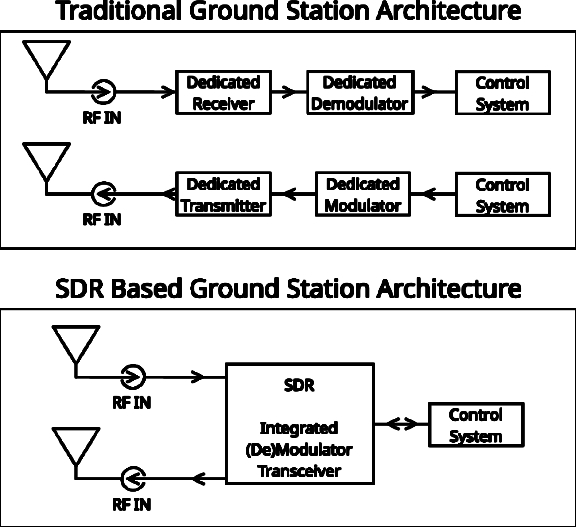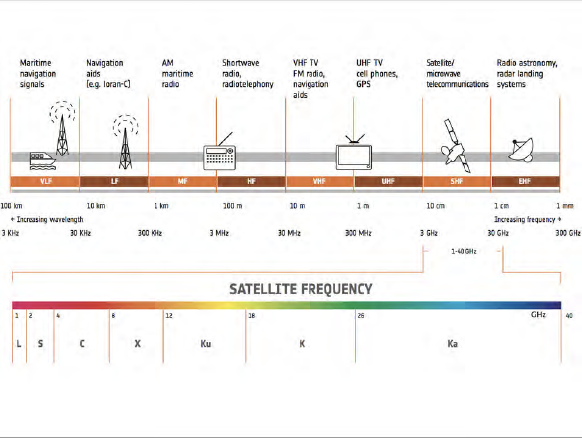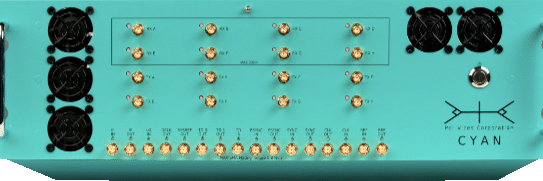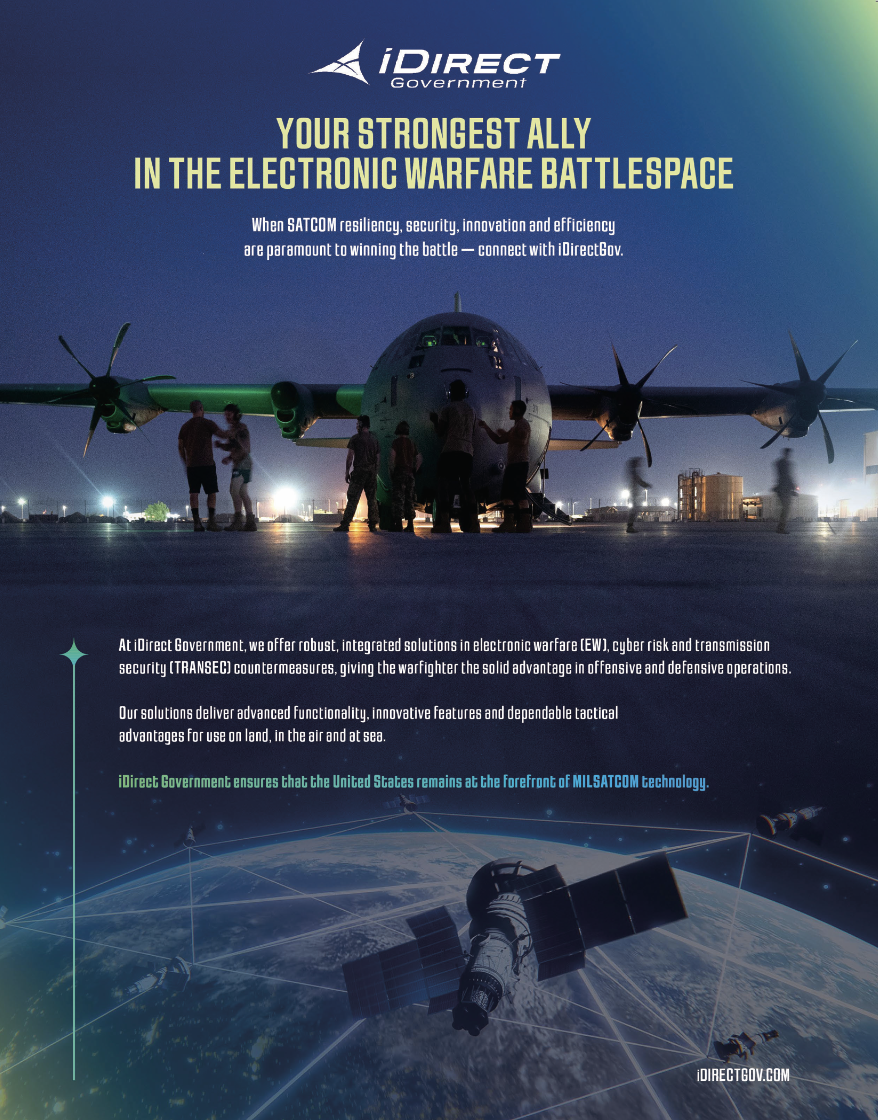In the ever-evolving domain of modern communication, ground systems and networks are experiencing a paradigm shift, driven by the fusion of Software Defined Radios (SDRs) and high-performance Field-Programmable Gate Arrays (FPGAs).
 Figure 1: Comparing Traditional and SDR Based Ground Station Architectures. Source: Per Vices Corporation
Figure 1: Comparing Traditional and SDR Based Ground Station Architectures. Source: Per Vices Corporation
These sophisticated communication devices operate on a paradigm where radio functionality is defined and redefined dynamically through software updates. As we delve into the multifaceted nature of SDRs, it’s crucial to understand their pivotal role in reshaping ground systems and networks.
SDRs represent a shift from traditional hardware-centric radio systems to software-driven, adaptable solutions, offering unparalleled flexibility and capabilities in various domains.
This article delves into the intricacies of this transformative alliance, exploring the extended capabilities of SDRs and the additional benefits brought forth by the incorporation of high- performance FPGAs. Together, they redefine the landscape of ground systems and networks, offering unparalleled flexibility and performance.
Software Defined Radios (SDRs) Software Defined Radios (SDRs) represent a revolutionary advancement in radio communication technology. Unlike traditional radios that rely on fixed hardware configurations for specific frequency bands, SDRs are characterized by their dynamic adaptability.
The core innovation lies in the software-controlled functionality, allowing users to reconfigure the radio’s operating parameters through software updates. This flexibility enables SDRs to operate across a wide range of frequencies and standards, making them exceptionally versatile in various applications such as military communication, emergency response systems, terrestrial radio, and satellite communication.
SDRs bring unprecedented adaptability and efficiency to the field of radio communication, serving as a bridge between the traditional hardware-centric approach and the evolving demands of modern communication systems.
Overall Usage in Satellite Ground Systems: The architecture of a satellite ground station is a meticulously designed framework that plays a pivotal role in establishing communication with satellites in orbit. Typically composed of antennas, receivers, demodulators, and control systems, a ground station serves as the vital interface between terrestrial networks and orbiting satellites.
In this architecture, SDRs seamlessly integrate as a transformative component. SDRs, characterized by their ability to dynamically modify radio functions through software
updates, are strategically positioned within the ground station’s architecture. Their adaptability allows for dynamic tuning across various frequency bands, ensuring compatibility with diverse satellite communication protocols.
SDRs enhance the station’s flexibility by enabling real-time adjustments to accommodate different satellite missions, optimizing signal reception and processing. Moreover, SDRs often find application in high-performance tasks such as channelization and signal processing, ensuring that the ground station can efficiently handle the complexities of modern satellite communication within its architectural framework.
Extended + Flexible Tuning Range
At the nucleus of SDRs lies their extended and flexible tuning range, a distinctive departure from the rigid hardware configurations of traditional radios. The dynamic nature of SDRs allows them to adapt seamlessly to a spectrum of frequency bands through software programming.
This adaptability is particularly vital in scenarios requiring dynamic frequency allocation, such as military operations, satellite communications, and disaster response efforts. SDRs empower ground systems with the agility to navigate diverse and evolving communication environments effortlessly, ushering in a new era of adaptability. (See Figure 2)
High Channel RFE (Radio Front End): Delving into the intricacies of SDRs, their high channel Radio Front End (RFE) capabilities emerge as a cornerstone in signal reception, filtering, and initial processing. This feature empowers SDRs to process multiple signals concurrently, optimizing spectrum utilization and bolstering communication reliability.
The significance of high channel RFEs becomes pronounced in environments saturated with diverse signals, where traditional radios might falter.
SDR equipped ground systems, fortified with high channel RFE, navigate complex signal landscapes with finesse, finding applications in urban communication networks and military operations.
Further elevating the capabilities of SDRs is their support for multiple Digital Signal Processing (DSP) channels per RFE.
The integration of high-performance FPGAs introduces an added dimension to the capabilities of SDRs enabling advanced channelization, gain, and other forms of DSP within the bandwidth of each RFE.
The FPGA-based channelization elevates the high channel RFE capabilities of SDRs, making ground systems adept at managing crowded frequency spectrums and ensuring reliable communication in challenging environments. The DSP further encompasses intricate tasks such as modulation, demodulation, filtering, and error correction.
The ability of SDRs to concurrently support multiple DSP channels within a single RFE not only facilitates parallelized and accelerated signal processing tasks but also augments overall system performance. This capability is particularly advantageous in scenarios necessitating high data throughput, as observed in broadband communication and data-intensive applications.

Figure 2: Spectrum of Satellite Communication Bands Source: European Space Agency (ESA)
High RF Bandwidths
A defining feature of SDRs lies in their capacity to support high Radio Frequency (RF) bandwidths. This capability assumes paramount significance in applications such as satellite communication, where the amount of data is extensive as it traverses considerable distances.
SDR equipped ground systems, with their advanced hardware and software architecture, ensure reliable and high-throughput communication even in challenging environments. The high RF bandwidths offered by SDRs pave the way for enhanced data rates, contributing to the efficiency of communication networks.
High Digital Throughput — 4x100GigE The pinnacle of digital throughput capabilities is achieved through the seamless integration of SDRs with high-performance FPGAs offering interfaces like 4x100GigE. This combination not only facilitates data transfer rates of up to 400 gigabits per second but also harnesses FPGA capabilities to streamline and optimize data processing, ensuring real-time efficiency.
In applications demanding swift and reliable data transfer, such as surveillance systems and SATCOM, this integrated approach positions ground systems at the forefront of communications.

Figure 3: Example of High Channel Count SDR (Cyan) Source:
Per Vices Corporation
Challenges + Considerations
In the pursuit of these myriad advantages, it is imperative to acknowledge and address the challenges associated with the implementation of SDRs. Within the industry, the greatest
concern has been the heightened vulnerability to cyber threats, given the reliance on software-driven programmable elements. There have however been significant advancements in the integration and implementation of SDRs which include robust cybersecurity measures to safeguard ground systems against potential breaches.
Secondly, the inherent complexity of many SDRs sometimes necessitates specialized knowledge for integration, configuration and maintenance, underscoring the importance of manufacturers offering either comprehensive training programs or integration support to harness the full potential of SDR equipped ground systems.
In conclusion, the convergence of Software Defined Radios and high-performance FPGAs unfolds a new era in ground systems and networks. Their extended tuning range, high channel count with channelization capabilities supporting multiple DSP channels per RFE, and optimization of high RF bandwidths collectively redefine the landscape of modern communication.
As ground systems evolve to meet the demands of an interconnected world, the collaborative potential of SDRs and high-performance FPGAs promises not only unparalleled flexibility but also a performance benchmark that sets the stage for advanced communication systems.
www.pervices.com

Author Brandon Malatest is the COO and Co-Founder of Per Vices Corporation, a leader in Software Defined Radio technology. Brandon has an honour’s degree in Physics with a specialization in Experimental Physics from the University of Waterloo in Ontario, Canada.
The com
Brandon Malatestpany produces software defined radios, offering the highest channel count and bandwidth SDRs for the satellite ground station market. The high performance radios with exceptional signal processing capabilities, DSP resources, and advanced hardware features enables customers to leverage Per Vices SDRs to achieve superior performance, enhanced flexibility, and future-proof solutions. Contact solutions@pervices.com to learn more about the different options available.



